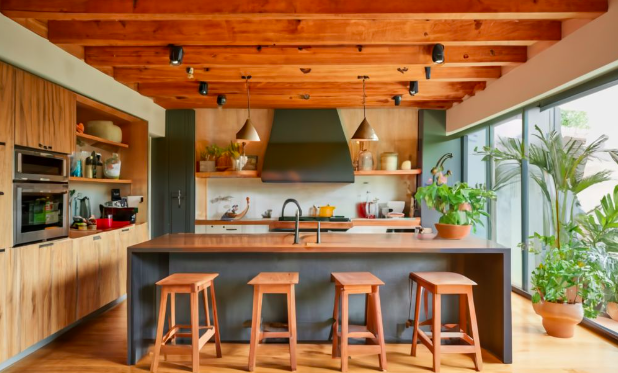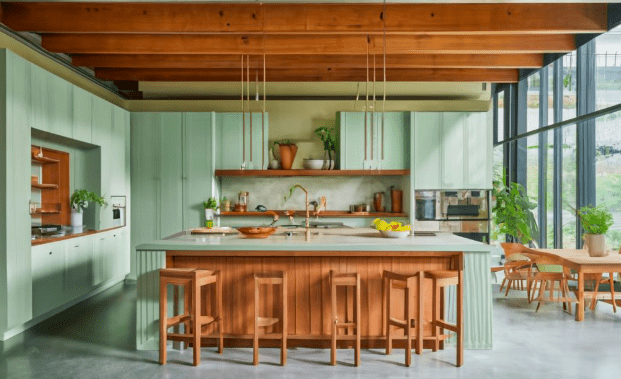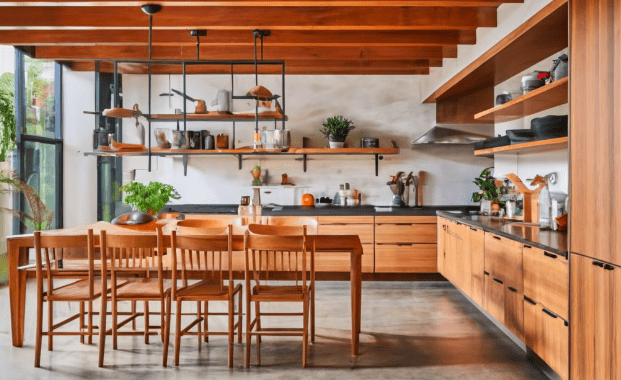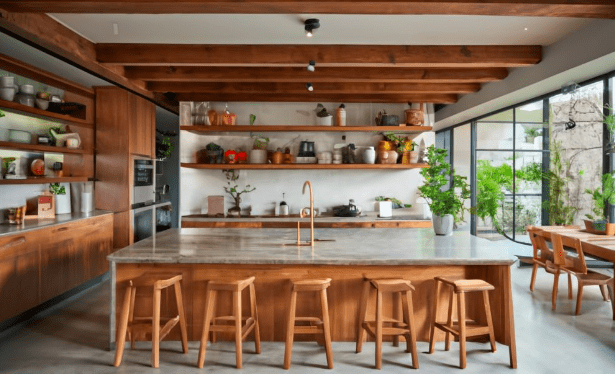Imagine whipping up delicious meals in a kitchen that’s not only beautiful and functional but also kind to the planet. Sounds like a dream, right? Well, with sustainable and eco-friendly kitchen design, it’s a reality within reach. Ditch the guilt of traditional kitchens brimming with waste and energy consumption – it’s time to embrace a green lifestyle that starts right at the heart of your home.

The Environmental Cost of Traditional Kitchens
Before we dive into eco-friendly solutions, let’s face the sobering truth. Traditional kitchens can be major environmental culprits. The average kitchen renovation generates a whopping 8 tonnes of waste, according to the National Association of Home Builders. Additionally, outdated appliances and practices guzzle energy and water, contributing to resource depletion and greenhouse gas emissions. But fear not! By making conscious choices and incorporating sustainable design principles, you can significantly reduce your kitchen’s environmental footprint.
Material Matters: Building a Green Foundation
The first step to a sustainable kitchen is choosing the right materials. Luckily, there are plenty of eco-friendly options available:
- Locally Sourced: Opt for materials like bamboo, reclaimed wood, or recycled plastic sourced within your region. This minimizes transportation emissions and supports local businesses.
- Recycled and Sustainable: Embrace the beauty of recycled countertops made from glass, paper, or concrete. Consider certified sustainable wood like Forest Stewardship Council (FSC) options for cabinetry.
- Low-VOC Finishes: Choose paints, adhesives, and finishes with low volatile organic compounds (VOCs) to improve indoor air quality for you and your family.

Energy Efficiency: Power Up Responsibly
Your kitchen appliances are energy guzzlers, so choosing energy-efficient models is crucial. Look for the Energy Star label, which signifies appliances that use 20-50% less energy than standard models. Don’t stop there:
- LED Lighting: Ditch traditional incandescent bulbs for energy-efficient LEDs that use up to 80% less energy and last 25 times longer.
- Renewable Energy: Consider installing solar panels to generate your own clean energy for your kitchen appliances and beyond.
- Smart Appliances: Invest in smart appliances that allow you to monitor and control energy usage remotely, optimizing efficiency and reducing waste.

Water Conservation: Every Drop Counts
Every drop of water saved makes a difference. Here’s how to turn your kitchen into a water conservation zone:
- Low-Flow Fixtures: Install low-flow faucets and showerheads in your sink and dishwasher. These can save up to 2 gallons of water per minute, significantly reducing your water consumption.
- Water-Efficient Appliances: Choose water-efficient models when replacing your dishwasher and washing machine. Look for features like water-saving cycles and sensor technology.
- Rainwater Harvesting: Capture rainwater from your roof in a storage system for non-potable needs like watering plants or flushing toilets. This can significantly reduce your reliance on municipal water supplies.

Waste Not, Want Not: Minimize & Manage Waste
Food waste is a major environmental issue, and kitchens are often ground zero. Here’s how to combat it:
- Composting: Set up a compost bin for food scraps and yard waste. This organic matter decomposes into nutrient-rich compost, ideal for your garden.
- Embrace Reusables: Ditch single-use plastics and opt for reusable containers for leftovers, shopping bags, and food storage.
- Choose Wisely: When buying groceries, prioritize products with minimal packaging and support companies committed to sustainable practices.

Beyond the Basics: Eco-Friendly Touches
Take your green kitchen to the next level with these additional touches:
- Natural Ventilation: Maximize natural light and ventilation whenever possible. Open windows and skylights can reduce reliance on artificial lighting and cooling systems.
- Energy-Saving Gadgets: Consider smart plugs and power strips that automatically shut off appliances when not in use.
- Greener Cleaning Products: Opt for natural and biodegradable cleaning products that are gentler on the environment and your health.

Conclusion
By adopting sustainable practices in your kitchen, you’re not just creating a beautiful and functional space, you’re making a positive impact on the planet. It’s a win-win situation for you, your family, and the environment. At SheInterior, we are committed to helping you create the sustainable kitchen of your dreams. Our team of expert designers and contractors will work with you every step of the way to ensure that your vision becomes a reality. Contact us today to schedule a consultation and take the first step towards your sustainable dream kitchen.

